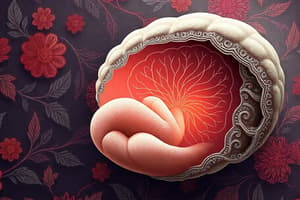Podcast
Questions and Answers
A connective tissue disorder affecting collagen formation during bone development is characteristic of which condition?
A connective tissue disorder affecting collagen formation during bone development is characteristic of which condition?
- Spinal muscular atrophy type 2
- Craniosynostosis
- Osteogenesis imperfecta (correct)
- Muscular dystrophy
Positive Gower's sign, scoliosis, and calf deformation are clinical indicators most commonly associated with which disorder?
Positive Gower's sign, scoliosis, and calf deformation are clinical indicators most commonly associated with which disorder?
- Muscular dystrophy (correct)
- Spinal Muscular Atrophy
- Osteogenesis Imperfecta
- Scleroderma
In the context of pediatric sports injuries, what is the primary focus regarding growth plate fractures?
In the context of pediatric sports injuries, what is the primary focus regarding growth plate fractures?
- Immediately immobilizing the limb without further assessment
- Encouraging immediate weight-bearing to promote healing
- Classifying the fracture type to guide appropriate management (correct)
- Prescribing high-dose anti-inflammatory medication
If a young athlete presents with hip pain, a limp, and limited range of motion, which condition should be considered, especially in the context of pediatric sports-related issues?
If a young athlete presents with hip pain, a limp, and limited range of motion, which condition should be considered, especially in the context of pediatric sports-related issues?
Which of the following is the MOST critical initial step in managing a suspected growth plate fracture in a young athlete?
Which of the following is the MOST critical initial step in managing a suspected growth plate fracture in a young athlete?
Which of the following is the MOST comprehensive list of early clinical signs associated with Autism Spectrum Disorder (ASD)?
Which of the following is the MOST comprehensive list of early clinical signs associated with Autism Spectrum Disorder (ASD)?
Which factor is MOST directly associated with the development of positional plagiocephaly in infants?
Which factor is MOST directly associated with the development of positional plagiocephaly in infants?
If an infant presents with left torticollis, what is the TYPICAL presentation of their head and chin position?
If an infant presents with left torticollis, what is the TYPICAL presentation of their head and chin position?
What is the PRIMARY underlying cause of Osteogenesis Imperfecta (OI)?
What is the PRIMARY underlying cause of Osteogenesis Imperfecta (OI)?
Which of the following is a COMMON sign or symptom associated with Osteogenesis Imperfecta (OI)?
Which of the following is a COMMON sign or symptom associated with Osteogenesis Imperfecta (OI)?
What is a PRIMARY focus of physical therapy intervention for individuals with Osteogenesis Imperfecta (OI)?
What is a PRIMARY focus of physical therapy intervention for individuals with Osteogenesis Imperfecta (OI)?
What is the MAIN characteristic of Muscular Dystrophy?
What is the MAIN characteristic of Muscular Dystrophy?
Which of the following is TRUE regarding the inheritance pattern of Duchenne Muscular Dystrophy (DMD)?
Which of the following is TRUE regarding the inheritance pattern of Duchenne Muscular Dystrophy (DMD)?
Which of the following clinical presentations is COMMONLY associated with Muscular Dystrophy?
Which of the following clinical presentations is COMMONLY associated with Muscular Dystrophy?
What does a 'Positive Gower's Sign' indicate in the context of Muscular Dystrophy?
What does a 'Positive Gower's Sign' indicate in the context of Muscular Dystrophy?
In Duchenne Muscular Dystrophy (DMD), what pathological change occurs in muscles as the disease progresses?
In Duchenne Muscular Dystrophy (DMD), what pathological change occurs in muscles as the disease progresses?
Why is creatine phosphokinase (CPK) level typically elevated in individuals with Muscular Dystrophy?
Why is creatine phosphokinase (CPK) level typically elevated in individuals with Muscular Dystrophy?
What is the primary goal of using corticosteroid medications like prednisone in the medical management of Muscular Dystrophy?
What is the primary goal of using corticosteroid medications like prednisone in the medical management of Muscular Dystrophy?
Which of the following is the MOST important consideration when prescribing exercises for a patient with Muscular Dystrophy?
Which of the following is the MOST important consideration when prescribing exercises for a patient with Muscular Dystrophy?
Why are night splints commonly used as part of the physical therapy management for individuals with Muscular Dystrophy?
Why are night splints commonly used as part of the physical therapy management for individuals with Muscular Dystrophy?
What is the primary reason individuals with Duchenne Muscular Dystrophy (DMD) typically succumb to cardiac or respiratory failure?
What is the primary reason individuals with Duchenne Muscular Dystrophy (DMD) typically succumb to cardiac or respiratory failure?
A child with DMD often uses the Gower's maneuver to stand up. What does the Gower's maneuver indicate about the child's condition?
A child with DMD often uses the Gower's maneuver to stand up. What does the Gower's maneuver indicate about the child's condition?
Which exercise type should be approached with caution or avoided in physical therapy interventions for Muscular Dystrophy?
Which exercise type should be approached with caution or avoided in physical therapy interventions for Muscular Dystrophy?
Why are growth plate injuries more common in children than joint injuries when trauma occurs near a joint?
Why are growth plate injuries more common in children than joint injuries when trauma occurs near a joint?
Which of the following best describes an apophyseal fracture, unique to the pediatric population?
Which of the following best describes an apophyseal fracture, unique to the pediatric population?
How does a growth plate fracture in a child potentially lead to biomechanical problems later in life?
How does a growth plate fracture in a child potentially lead to biomechanical problems later in life?
According to the Salter-Harris classification, which type of fracture involves a break through the growth plate and a portion of the bone's shaft (metaphysis)?
According to the Salter-Harris classification, which type of fracture involves a break through the growth plate and a portion of the bone's shaft (metaphysis)?
Which Salter-Harris fracture type has the highest risk of growth disturbance?
Which Salter-Harris fracture type has the highest risk of growth disturbance?
Why is a Salter-Harris Type I fracture sometimes difficult to diagnose initially?
Why is a Salter-Harris Type I fracture sometimes difficult to diagnose initially?
A child presents with pain and swelling near the knee after a fall. Radiographs reveal a fracture line extending through the epiphysis and growth plate to the articular surface of the bone. Which Salter-Harris classification does this injury fall under?
A child presents with pain and swelling near the knee after a fall. Radiographs reveal a fracture line extending through the epiphysis and growth plate to the articular surface of the bone. Which Salter-Harris classification does this injury fall under?
In a Salter-Harris Type IV fracture, which anatomical structures are involved?
In a Salter-Harris Type IV fracture, which anatomical structures are involved?
Following a growth plate injury, what is a potential long-term complication affecting bone growth that clinicians should monitor for?
Following a growth plate injury, what is a potential long-term complication affecting bone growth that clinicians should monitor for?
A young athlete complains of chronic knee pain. Imaging reveals an injury to the distal femur involving only the growth plate with no associated fracture of the surrounding bone. Which Salter-Harris classification is most likely?
A young athlete complains of chronic knee pain. Imaging reveals an injury to the distal femur involving only the growth plate with no associated fracture of the surrounding bone. Which Salter-Harris classification is most likely?
A physical therapist is evaluating a 5-year-old boy recently diagnosed with Legg-Calve-Perthes disease. Which examination finding is MOST consistent with this condition in the acute phase?
A physical therapist is evaluating a 5-year-old boy recently diagnosed with Legg-Calve-Perthes disease. Which examination finding is MOST consistent with this condition in the acute phase?
What is the PRIMARY goal of physical therapy intervention for a child diagnosed with Legg-Calve-Perthes disease?
What is the PRIMARY goal of physical therapy intervention for a child diagnosed with Legg-Calve-Perthes disease?
Which of the following is considered a significant risk factor for the development of Legg-Calve-Perthes disease?
Which of the following is considered a significant risk factor for the development of Legg-Calve-Perthes disease?
Avascular necrosis of the femoral head is a key component of Legg-Calve-Perthes Disease. What is the MOST accurate description of this process?
Avascular necrosis of the femoral head is a key component of Legg-Calve-Perthes Disease. What is the MOST accurate description of this process?
An 6-year-old is diagnosed with Legg-Calve-Perthes disease. Considering the typical prognosis associated with age, which outcome is MOST likely?
An 6-year-old is diagnosed with Legg-Calve-Perthes disease. Considering the typical prognosis associated with age, which outcome is MOST likely?
What potential long-term complication is MOST associated with Legg-Calve-Perthes disease, even after the initial condition has resolved?
What potential long-term complication is MOST associated with Legg-Calve-Perthes disease, even after the initial condition has resolved?
Avascular necrosis of the femoral head is a key feature of Legg-Calve-Perthes disease, ultimately affecting joint congruity. What later intervention might be required if the bones don't fit well together?
Avascular necrosis of the femoral head is a key feature of Legg-Calve-Perthes disease, ultimately affecting joint congruity. What later intervention might be required if the bones don't fit well together?
Which of the following is TRUE regarding the etiology of Legg-Calve-Perthes disease?
Which of the following is TRUE regarding the etiology of Legg-Calve-Perthes disease?
Which intervention is LEAST likely to be found within the scope of practice for a Physical Therapist Assistant (PTA) working directly in the Neonatal Intensive Care Unit (NICU)?
Which intervention is LEAST likely to be found within the scope of practice for a Physical Therapist Assistant (PTA) working directly in the Neonatal Intensive Care Unit (NICU)?
In the context of the NICU, what does the abbreviation 'A's and B's' typically refer to?
In the context of the NICU, what does the abbreviation 'A's and B's' typically refer to?
A neonate is described as 'AGA'. What does this abbreviation indicate about the infant?
A neonate is described as 'AGA'. What does this abbreviation indicate about the infant?
What is the significance of understanding family dynamics and stressors when providing care for NICU graduates?
What is the significance of understanding family dynamics and stressors when providing care for NICU graduates?
Which technological advancement has MOST significantly contributed to improved survival rates for neonates in NICUs since the 1960s?
Which technological advancement has MOST significantly contributed to improved survival rates for neonates in NICUs since the 1960s?
A therapist is planning interventions for a 6-month-old infant who was recently discharged from the NICU. Which of the following considerations is MOST important for this therapist?
A therapist is planning interventions for a 6-month-old infant who was recently discharged from the NICU. Which of the following considerations is MOST important for this therapist?
What does the abbreviation 'PROM' indicate in the context of neonatal care?
What does the abbreviation 'PROM' indicate in the context of neonatal care?
A neonate requires feeding 'PO'. How is the neonate receiving nutrition?
A neonate requires feeding 'PO'. How is the neonate receiving nutrition?
Which of the following BEST describes the role of regional NICUs established in the 1960s?
Which of the following BEST describes the role of regional NICUs established in the 1960s?
What level of awareness should a therapist have regarding comprehensive care for NICU graduates?
What level of awareness should a therapist have regarding comprehensive care for NICU graduates?
Flashcards
Autism/ASD Signs
Autism/ASD Signs
Failure to babble/coo by 12 months, lack of response to name, and social isolation.
Positional Plagiocephaly Cause
Positional Plagiocephaly Cause
Infant favors a position in supine, leading to skull flattening.
Left Torticollis
Left Torticollis
Chin tilts to the right, and the head tilts to the left.
Osteogenesis Imperfecta (OI)
Osteogenesis Imperfecta (OI)
Signup and view all the flashcards
OI Signs/Symptoms
OI Signs/Symptoms
Signup and view all the flashcards
OI Physical Therapy
OI Physical Therapy
Signup and view all the flashcards
Muscular Dystrophy (MD)
Muscular Dystrophy (MD)
Signup and view all the flashcards
Types of MD
Types of MD
Signup and view all the flashcards
MD Clinical Signs
MD Clinical Signs
Signup and view all the flashcards
Gower's Sign
Gower's Sign
Signup and view all the flashcards
Osteogenesis Imperfecta
Osteogenesis Imperfecta
Signup and view all the flashcards
Muscular Dystrophy
Muscular Dystrophy
Signup and view all the flashcards
Scoliosis
Scoliosis
Signup and view all the flashcards
Legg-Calvé-Perthes Disease
Legg-Calvé-Perthes Disease
Signup and view all the flashcards
Muscular Dystrophy: Calves
Muscular Dystrophy: Calves
Signup and view all the flashcards
Gower's Maneuver
Gower's Maneuver
Signup and view all the flashcards
Muscle Biopsy Findings (MD)
Muscle Biopsy Findings (MD)
Signup and view all the flashcards
Increased CPK Levels (MD)
Increased CPK Levels (MD)
Signup and view all the flashcards
Corticosteroids and MD
Corticosteroids and MD
Signup and view all the flashcards
PT Interventions for MD
PT Interventions for MD
Signup and view all the flashcards
Equipment for MD
Equipment for MD
Signup and view all the flashcards
MD Exercise Precautions
MD Exercise Precautions
Signup and view all the flashcards
Growth Plates
Growth Plates
Signup and view all the flashcards
Apophyseal Fracture
Apophyseal Fracture
Signup and view all the flashcards
Physeal Fracture
Physeal Fracture
Signup and view all the flashcards
Salter-Harris Type I
Salter-Harris Type I
Signup and view all the flashcards
Salter-Harris Type II
Salter-Harris Type II
Signup and view all the flashcards
Salter-Harris Type III
Salter-Harris Type III
Signup and view all the flashcards
Salter-Harris Type IV
Salter-Harris Type IV
Signup and view all the flashcards
Salter-Harris Type V
Salter-Harris Type V
Signup and view all the flashcards
Age related risk of fractures
Age related risk of fractures
Signup and view all the flashcards
Growth alteration
Growth alteration
Signup and view all the flashcards
Internal Rotation & Abduction
Internal Rotation & Abduction
Signup and view all the flashcards
Perthes Disease
Perthes Disease
Signup and view all the flashcards
Perthes Cause
Perthes Cause
Signup and view all the flashcards
Perthes Age
Perthes Age
Signup and view all the flashcards
Perthes Gender
Perthes Gender
Signup and view all the flashcards
Perthes Race
Perthes Race
Signup and view all the flashcards
Perthes Complication
Perthes Complication
Signup and view all the flashcards
Perthes Treatment Goals
Perthes Treatment Goals
Signup and view all the flashcards
Pediatric Treatment Options
Pediatric Treatment Options
Signup and view all the flashcards
Neonate Care
Neonate Care
Signup and view all the flashcards
A's and B's
A's and B's
Signup and view all the flashcards
AGA
AGA
Signup and view all the flashcards
BW
BW
Signup and view all the flashcards
C-Section
C-Section
Signup and view all the flashcards
MCA
MCA
Signup and view all the flashcards
PO
PO
Signup and view all the flashcards
PROM
PROM
Signup and view all the flashcards
PTL
PTL
Signup and view all the flashcards
Study Notes
- PowerPoint #7 discusses various pediatric conditions and interventions.
- This includes congenital disorders, arthrogryposis multiplex congenita (AMC), Down syndrome (DS), spina bifida, autism spectrum disorders (ASD), congenital muscular torticollis (CMT), Osteogenesis Imperfecta (OI), and Muscular Dystrophy.
Arthrogryposis Multiplex Congenita (AMC)
- AMC is a non-progressive syndrome involving multiple congenital joint contractures with a symmetric pattern in all four limbs.
- The pathology is a motor syndrome of unknown origin, often occurring in the first trimester of fetal development.
- Lack of fetal movement during pregnancy is a characteristic.
- Potential causes include maternal fevers, infections, vascular compromise, limited uterine space/low amniotic fluid, muscle atrophy, small uterus, CNS/spinal cord deformities, and atypical development of tendons, bones, joints, or joint linings.
- In 1/3 of AMC cases, there is a genetic cause on chromosome 5, or distal AMC traced to chromosome 9.
- Clinical Signs of AMC include multiple joint involvement with contractures, deformities present at birth, muscle atrophy with decreased strength, possible absences of muscle groups, lack of normal skin creases, and diminished tendon reflexes.
- Common joint involvements include hands, wrists, elbows, ankles, knees, and hips.
- Medical intervention includes transdisciplinary team approach with orthopedic surgeon, PT, OT, family and child.
- It also includes orthopedic surgeries timed according to development.
- An example: club foot deformity with the heel pointing downward and the forefoot turning inward should have surgery prior to standing/ambulating, done between 6 and 12 months.
- Common hip dislocation, if bilateral, usually does not have surgery due to level pelvis; if only one dislocates, surgery is considered to balance out the pelvis and prevent scoliosis.
- PT assessment involves goniometry for A/PROM of limbs/trunk, strength, protective extension, equilibrium reactions, gross motor skills, transitions, mobility, and ADL's.
- PT Interventions include addressing limitations in ROM and decreased muscle strength, using intensive stretching/strengthening, and age-appropriate intervention.
- HEP is integrated into the family and child's routine.
- Functional independence in upper extremities is a priority, particularly elbow flexion/extension for independence in ADL’s.
- Infants require serial casting, splinting, and family/caregiver education on holding, feeding, and sleeping positions.
- Toddlers need strengthening and stretching incorporated into play schemes, with a focus on ambulation, mobility, pulling to stand, and object manipulation (ball skills).
- Self-feeding and beginning dressing should also be incorporated.
- Pre-school and school-age goals should be modified to reflect age-appropriate skills and these children are typically fully included in the regular education system, with adaptive PE and therapies outlined in IEP.
Down Syndrome (DS)
- DS is named after John Langson Down in 1866.
- The genetic error was isolated in 1959 by Lejeune that demonstrated an atypical chromosome count.
- Pathology involves three types of chromosomal abnormalities, where Trisomy 21 is the most common (~95%, more frequently seen in males), Translocation (5%, more often in females), and Mosaicism (1%, some cells have it and some don't).
- Incidence is approximately 1 in 700 live births in 2010.
- The risk of Down syndrome increases with maternal age and advancing paternal age plays a role as well.
- Clinical signs and physical features include Hypotonia, short stature, a flat facial profile, protruding tongue, epicanthal folds, upward slanting eyes, small ears, single transverse palmar crease, cognitive deficits, speech & motor delays, and joint hypermobility.
- There are additional or secondary concerns, such as - congenital heart defects, increased risk for leukemia (in younger children), atlantoaxial instability (excessive mobility between C1-C2), risk for respiratory infections and others.
- Atlantoaxial instability (excessive mobility between C1-C2) might cause upper motor neuron lesion.
- Signs of the motor neuron lesions include clumsiness, incontinence, sensory changes, easy fatigability, and decreased neck mobility with possible torticollis.
- Medical intervention includes addressing cardiac valve defects, endocardial cushion defects (holes in their heart); they may require surgical intervention.
- Other interventions include interventions for nutrition burning 15% fewer calories than peers, monitoring for orthopedic co-morbidities, and early intervention programs to address cognitive, fine motor and gross motor delays, and social skills.
- PT Interventions: Focus on assisting the child to become functional/independent.
- Early intervention focuses on developmental and coordination skills, stability at proximal joints, co-contraction, promoting early development of motor skills, pre-ambulation, standing balance, developmental sequence activities, and engaging/supporting the family.
- PT also includes caregiver/parent education on handling, carrying & positioning, balance reactions in sitting and standing, and gait activities (potentially needing orthotics).
- The SureStep flexible SMO (supramalleolar orthotic) works with children who have low tone.
Spina Bifida
- Spina Bifida literally means "cleft spine," involving incomplete closure of the spinal column.
- It is a neural tube defect that can be detected at four months of gestation via imaging, diagnostics & lab tests (alpha-fetoprotein AFP), or amniocentesis.
- Elevated AFP in amniocentesis indicates potential spina bifida.
- Levels of spina bifida include Occulta, Meningocele (cystica), and Myelomeningocele.
- Spina Bifida Occulta: the neural arches do not connect, however there is no neural material located outside of spinal canal.
- It's the most common type, typically involving the lower lumbar spine, and is usually benign.
- Spina Bifida Cystica Meningocele occurs when the meninges protrude thru the opening of the spinal column (3 protective membranes covering the brain and spinal cord) in a cyst covered with epithelium.
- The spinal cord is not trapped and the child may experience no symptoms, while some experience bowel and bladder dysfunction.
- Spina Bifida-Myelomeningocele is when both the spinal cord and meninges protrude through the vertebral defect into a sac (cyst) or open area in back and there is cerebral spinal fluid and possibly nerve roots.
- Spinal cord may be visible and exposed, is a high risk factor for infection, malformed or incomplete, and the skin at the lesion would rarely be itact.
- The condition typically occurs in lumbosacral area and involves flaccid LE’s with loss of sensation below level of myelomeningocele.
- Clinical Signs of Myelomeningocele include flaccid paralysis in LE's, muscle weakness/wasting, atypical deep tendon reflexes.
- It also includes loss of sensation below level of myelomeningocele, possible incontinence and 80% have hydrocephalus.
- Conditions Resulting from Myelomeningocele include abnormalities of the brain: Arnold-Chiari malformation (type 2) which is the malformation in the base of the brain (cerebellum, pons and medulla) where it is elongated and protrudes into the foramen magnum.
- Hydrocephalus affects 80% of children, which is Is the enlargement of the brain due to an increase in cerebrospinal fluid in the ventricles.
- hydrocephalus can be corrected with surgery, where a narrow surgical tube is inserted into the ventricle and threaded under the skin behind the ear by draining CSF from the brain and into the gut.
- Bowel and bladder dysfunction can result from Meningocele and Myelomeningocele.
- For example, Incontinence managed by catheterization and there is a latex allergy present in up to 73% of patients.
- It could also result in difficulties with social as well as emotional development, osteoprosis, and/or can also result in Tethered cord syndrome.
- This occurs when spinal cord is fixed caudally because of pathology or from from an earlier surgical repair, or from an earlier surgical repair.
- In this spinal cord becomes stretched , distorted , and ischemic, and may show atypical neurological signs such as spasticity in L/E.
- A related (to spina bifida) form of Occult Spinal Dysraphism (OSD) is typically seen in spina bifida occulta.
- OSD, which is a condition in which there is a noticeable abnormality in the child's lower back, which would be displayed by with the child is a birthmark, tufts of hair, small opening in skin, or a small lump/sacral dimple. Interventions for Spina Bifida include shunt care for hydrocephalus and proper skin care to prevent skin breakdown.
- Families should be allied with the medical team, get a support group, and wear the child should wear orthotics,
- Other modes of interventions use the following with- wheeled mobility and PT/OT.
- PT should assist the child with physical therapy, and to help improve their their functional abilities. The interevention include, which will depend on the child's lesion level, functional abilities and age and help focus bed mobility, transfers, and recreational activities.
Autism and Autism Spectrum Disorders (ASD)
- Children often have one or more of the following disorders: ADD or ADHD, Anxiety disorder, Deafness, Depression, OCD, Tourette syndrome, as well as mental retardation/seizures .
- Early diagnosis and treatment can substantially improved outcomes.
- The Screening and Evaluation Tools involve using The Ages (and Stages) Questionnaire- 2nd Edition (ASQ), but can also include various other tests such as Childhood Autism Rating Scale(CARS).
- Intervention for it involves communication, working on their ABA program, helping them to improve Social Skills by helping them woth Sensory, Fine motor and ADL's.
Congenital Muscular Torticollis (CMT)
- CMT causes involuntary neck contraction to one side due to contraction of the sternocleidomastoid muscle.
- The head presents laterally flexed with the chin facing the opposite direction, and the word "torticollis" means twisted neck.
- It is typically not evident at birth but diagnosed at 2-3 months old.
- Potential causes including breech position, malposition in uterus (overcrowding or multiple babies), birth trauma to soft tissues, and hypotonia (low muscle tone).
- There an enlarged mass that may or may not be non-tender .
- There is also decreased cervical ROM that is head has laterally tilted to left side with chin rotated toward right shoulder(or other side)
- The infant could also avoid rolling to that direction, can also have a position in that way.
- Associated Clinical Signs include positional plagiocephaly, which is when there is asymmetrical distortion of the skull and could affect the head.
OSTEOGENSIS Imperfactia
- The etiology would be from genetic inherantance as the bones are are very easy to fracture.
- There will be bowinf in the bones, scolious, kyphosis, and a bluish tint that is commonly displayed.
- Treatmeant for the diseases involves aquatic, use of mobility and strengthening.
Muscular Dystrophy
- Defects are in Muscle protein ,and the death of muscle cell is more likely within people with this condition.
- This will lead to limited ROM/Joint Contractures, and there is generally, impaired respiratory function with this case.
- False Muscle with this case,
Idiopathic Toe Walking
- According to the the Mayo Cinic is when" "walking with the foot on the toe", there may be altered Propiocetive processing, vestibular processing , and tactile
- May increase risk of falling.
- In these situation there would be shortening , of achillies tendon..
- Medical management requires, the patient to engage in stretching and with orthotics so that the person has assistance with balance .
Pediactric Injuries
- In pediatric these injures occur when at a youth period , especially to athletes .
- These injures occur around joint around youth and these these areas are weak , which means it becomes very easy to fracture, and the areas is where there is vertebral joints.
- The injuries could apophyseal fractures, where there is a injury in the growth cartilag.
- It is recommend that the patient to rest.
- Type 1 is the ,through growth plate, through the growth
- It i simprotant to let the bone heal.
In the Neonatal Unit
- Care for the neonate needs specialized skills and knowledge.
- The physical therpist must take great care since these patients are fragile.
- The team would have to have to have to come to a"clustered" effect so the child can function at their fullest .
- It is imporatnt in a new natal infant for them to be assessed since since it provides the assessment tool.
Studying That Suits You
Use AI to generate personalized quizzes and flashcards to suit your learning preferences.




